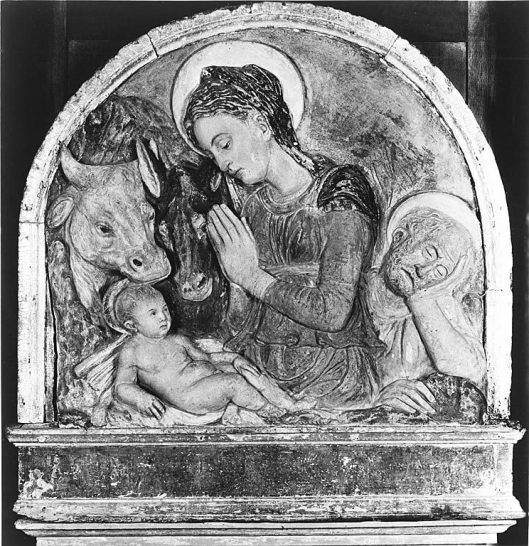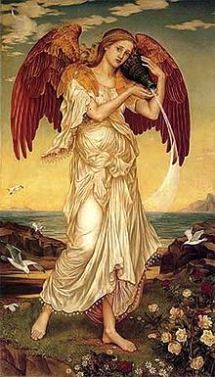
Donatello, Circle of Italian, 1386/7-1466 The Nativity, c. 1465 (Photo credit: Wikipedia)
Christmas: the winter solstice
The Roman Saturnalia
As we have seen in earlier posts, Christmas occurs on the day of the longest night or near the day of the longest night, the winter solstice (usually Dec. 21 or 22). This must have seemed unnatural in Greco-Roman antiquity.
In pre-Christian Rome, the longest night was celebrated by a reversal of roles. During the Roman Saturnalia, the slave was the master and the master, the slave. I suspect the ethnicity of slaves was the same as that of the slave owners.

Column krater with a komos and three maenads, Walters Museum of Art (Photo credit: Wikipedia)
The Greek Kōmos
Red figure and black-figure pottery – kylix – amphora – Maenads – Bacchus– phallic symbols
As for the Greeks, their celebration of the longest night was the Kōmos or comus, a drunken and disorderly procession, hence a reversal, order being the norm.[1] The revelers were called komast or kōmastaí. We have inherited magnificent red-figure and black-figure pottery depicting the Kōmos: the krater, the kylix (a rounded drinking bowl), amphoras and other vases or containers. Featured above is a krater, but that particular photograph does not show three Maenads, the wild female followers of Dionysus, or Bacchus, in Roman mythology. However, the image is described as portraying a Kōmos. Below is an amphora clearly depicting a Kōmos.

Kōmos scene, Attic black-figure amphora, ca. 560 BCE, Staatliche Antikensammlungen (Inv. 1432) (Photo credit: Wikipedia)
The Birth of Comedy
The Kōmos – the agōn– satyrs – Phallic symbols
Interestingly, the Greek Kōmos, the drunken and disorderly procession mentioned above, developed “into Greek Old comedy of the Dionysian festival in the 6th century BCE.” (See Kōmos, Wikipedia.) Satyrs are associated with satires. There exist other theories concerning the origin of comedy, but etymology points to a relationship, not only between Satyrs and satires, but also between the Kōmos and comedy.
Our best examples of Greek Old Comedy are the comedies of Greek playwright Aristophanes (c. 446 – c. 386 BCE)[2]. These feature an agōn,[3] which is, at times, a formal debate, but, at other times, a sham struggle usually opposing a young man and an old man. The old man could regain his youth and win the contest, but the more likely outcome of the agōn was the victory of the young man over the old man. The Kōmos is in fact a fertility ritual demanding a renewal. In the Old comedy of the ancients, even if a woman had not participated in the agōn, she suddenly appeared and a “marriage” was celebrated. Phallic symbols were used (See the image below, red-figure pottery).
Greek Old comedy – Middle Comedy – New Comedy
Ancient Greek comedy is divided into the three above-named periods. The plays of Aristophanes belong to the Old Comedy of ancient Greece. My favourite is Lysistrata (411 BCE), a play in which women deny men sexual privileges until they end the war, the Peloponnesian War (c. 431 BCE – 404 BC). Lysistrata is an ancient expression of our “make love, not war” and the women’s refusal to engage in sexual intercourse is a threat to the outcome of the comedy, comedies being a fertility ritual. Eleven of Aristophanes’ comedies have survived.
Old Comedy was followed by Middle Comedy (Antiphanes and Alexis, mainly) and New Comedy, the comedies of Menander (c. 341/ 42 – c. 290 BCE), its most important representative. Menander’s comedies were written shortly before the “Roman” comedies of Plautus (c. 254 – 184 BCE) and Terence (c. 195/185 – c. 159 BCE). According to Britannica, “[t]he Roman predecessors of Plautus in both tragedy and comedy borrowed most of their plots and all of their dramatic techniques from Greece.”[4] In other words, given that Plautus and Terence used techniques borrowed from Greek New Comedy, they may be ancestors to dramatists Shakespeare and Molière, but Greece is the primary source.
It remains, moreover, that the contest between the alazṓn and an eirôn, who are stock characters, took place in Old Comedy. It resembles the agōn. We know the alazṓn opposes the marriage of a young couple. The young lovers, often helped by a supporter or supporters, the eirôn, are able to overcome obstacles to their marriage. The blocking-character, or alazṓn, is defeated. So, if all is well that ends well, Greece seems the fountainhead.
Comedy has not changed significantly over the centuries, not to say millennia.
“Eos is the iconic original from which Christian angels were imagined, for no images were available from the Hebrew tradition, and the Persian angels were unknown in the West.” The image featured above is therefore precious. Eos, a Titaness, is the Greek Goddess of dawn, a counterpart to Rome’s Aurora. Eos’ brother is Helios, god of the sun, and her sister is Selene, goddess of the moon. (See Eos, Wikipedia.)
(See: http://www.mlahanas.de/Greeks/Mythology/Eos.html.)
Conclusion
The Beatitudes – the Sermon on the Mount – the New Testament
Christmas is therefore rooted in the Roman Saturnalia and the Kōmos. Seasons and human nature dictated festivities on the day of the longest day, Midsummer Day (June 20-21) and on days when night and day were of equal duration, the equinoctial points. Hence a degree of commonality between the raucous Kōmos and Christmas. For Christians, Midnight Mass and the réveillon, a copious and festive meal served, in Quebec, after, not before, Midnight Mass are a reversal. (See Réveillon, Wikipedia.)
Given that Jesus spoke in parables, the “kingdom of heaven” may be metaphorical. Yet, the Sermon on the Mount, the Beatitudes in particular, teach a new order. It promotes compassion and honours the humble, the meek, the just, the merciful, the pure, and the peace makers. (See Matthew 5 – 7.) The New Testament is therefore a reversal, but on many occasions Christians have not or would not listen. Judas betrayed Jesus of Nazareth.
Let us end this post, by noting that the longest night heralds the gradual return of light. Light is the norm. But were it not for darkness, light would have no meaning.
RELATED ARTICLES
- Angels & Archangels: Michael, Lucifer… (30 Nov 2014)
- Twelfth Night & Carnival Season (8 Jan 2014)
- The Four Seasons: from Darkness into Light.2 (6 Dec 2012)
- The Four Seasons: from Darkness into Light.1 (5 Nov 2011)
Sources and Resources
- Francis Macdonald Cornford’s The Origin of Attic Comedy is an online Archive.org.
- Sir James Gordon Frazer’s The Golden Bough A study of magic and religion [EBook #3623]
- The Golden Bough PDF
- https://www.biblegateway.com/passage/?search=Matthew%205-7
- http://www.theoi.com/Titan/Titanes.html
- http://www.mlahanas.de/Greeks/Mythology/Eos.html
- Lysistrata is the Project Gutenberg publication [EBook #7700]
- Britannica: Old Comedy, Middle Comedy and New Comedy
My kindest regards to all of you and very best wishes for the New Year. I have been too unwell to write, but I hope it will simply pass. I wish you a very happy New Year.
_________________________
[1] See Theodore H. Gaster (ed) Francis Macdonald Cornford, The Origin of Attic Comedy (New York: Doubleday & Company, 1961 [1914]).
[2] “Aristophanes”. Encyclopædia Britannica. Encyclopædia Britannica Online.
Encyclopædia Britannica Inc., 2014. Web. 28 dec.. 2014
<http://www.britannica.com/EBchecked/topic/34467/Aristophanes>.
[3] As in protagonist, antagonist, agony and in other words.
[4] “Plautus”. Encyclopædia Britannica. Encyclopædia Britannica Online.
Encyclopædia Britannica Inc., 2014. Web. 27 déc.. 2014
<http://www.britannica.com/EBchecked/topic/464334/Plautus/5775/Approach-to-drama>.

Eos, by Evelyn De Morgan, the Pre-Raphaelites
© Micheline Walker
22 December 2014
WordPress





One must not forget the Akitu festival of Sumer, 3,500 BC–12 days of a komos like reversal of roles and chaotic period in which the old king is replaced by a new one. A fine work on this is D. Stephenson Bond’s “The Archetype of Renewal.” Thank you for you clear exposition on the origins of Christmas.
LikeLiked by 1 person
I thank you for mentioning “The Archetype of Renewal.” I am currently refurbishing my PhD thesis (the pharmakos in 6 of Molière’s plays) and must go through the more recent literature on the subject. Posts cannot be exhaustive, but books are a different undertaking. In ancient days, the old king was often put to death…
Best wishes for the New Year,
Micheline
LikeLike
Happy New Year!
LikeLike
The same to you. Let it be our best year yet.
Micheline 🙂
LikeLiked by 1 person
Very well documented, thank you!
LikeLike
Thank you Christy,
Christmas is celebrated at the same time as pre-Christian festivities. It is an extraordinary story.
Best wishes for 2015. Here we are, fifteen years into the 21st century.
LikeLike
fascinating, thank you for this
Nx
LikeLike
Thank you Niki and a Happy New Year!
LikeLike
gosh yes 2015 already?!
LikeLike
Yes, already. It’s unbelievable. Happy New Year. 🙂
LikeLiked by 1 person
Pingback: FIFA15-COIN
Thank you very much. I hope it is bringing people pleasure.
Best,
Micheline
LikeLike